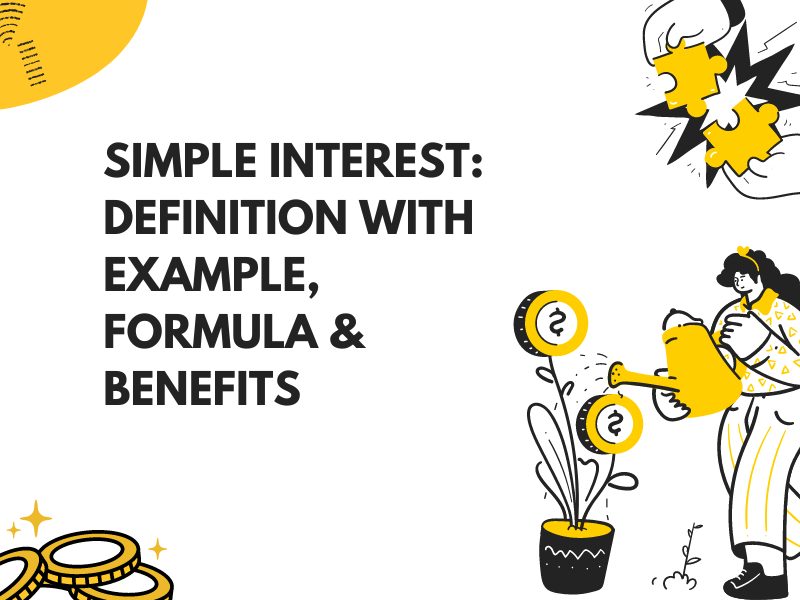Simple interest (S.I.) is a basic financial concept. It is easy to calculate the interest on the principal or loan amount. It is used in the financial sector, such as finance, banking, automobiles, etc. When you pay for the loan, the first payment goes to monthly interest, and the rest goes toward the principal amount.
This article will discuss definitions with Examples, formulas, how to calculate, and its benefits. If you want an easy and quick guideline for this interest rate, stay with us and read on.
What is Simple Interest
It is an easy calculation method; the interest on a loan always applies to the principal amount with the same interest rate for every time cycle. Generally, it sets a fixed interest rate for the duration of the loan and future payments will not be affected by previously accrued interest. It considers 3 factors when calculating Principal amount, rate of interest, and time.
Key points
- S.I doesn’t accumulate previous interest as compound interest
- It is speedy and easy to calculate the cost of your loan
- It is calculated by multiplying the interest rate by the principal amount.
S.I = (P*R*T)/100
Here, interest is earned, P is the Principal amount either borrowed or invested, R is the annual interest rate, and T is the time duration the interest is paid.
S.I = (P*R*T)/100
Example:
If you have invested $ 200 at 8% S.I. for 6 years, how much will you earn at the end of the period? The calculation formula is simple. You multiply the interest @ by the principal
I= (P*R*T)
P= 10,000
R= 8%/100=0.08
T= 6
I= $ 200*0.08*6 = $96
Read also: Simple Interest vs Compound Interest: Which Grows Your Money Faster?
What is the Difference between Simple Interest & Compound Interest?
The main difference between simple and compound interest is the calculation of interest. If explained in detail, this difference is easy to understand.
S.I. calculates the principal amount, while compound interest calculates both principal and accumulated interest from previous years. S.I. is commonly used in short-term loans, while compound interest is used in mortgages and savings accounts.
Basically, S. interest is paid on the initial principal only. For example, you deposit $4,000 into your bank account, and the annual interest rate is 8% for four years. How much interest do you gain after four years?
Use the S.I. the following formula.”
I=P*R*T (Where P is principal deposited, R is rate of interest, and T is time duration)
Use the following simple interest formula:
You get:
I=P*R*T
I=4000*0.08*4
I= $1,280.00
However, compound interest earned not only the principal amount but also gained interest on all interests earned previously. At the end of interest, add the principal amount, and the money is reinvested.
If you use compound interest for the above situation, then the interest will be compounding as follows:
Interest at the end of the 1st year: I=400*0.08*1= $320 and principal amount $4,000, and the total will be (Principal +Interest), (4,000+$320) = $4,320
Second year: I=$4,320*0.08*1=$ 345.60, your new principal will ($4,320+ $345.60) = $ 4,665.60
Third year: I=$4,665.60*0.08*1= $373.25, your new principal will ($ 4,665.60+$373.25) = 5038.85
Fourth year: I=$5,038.60*0.08*1=$403.11 and the new principal will ($5038.85+$403.11) = $5,441.96
Total interest earned in 4 years= $5,441.96- $4,000= $ 1,441.96
The difference amount between simple to compound interest is: ( $1,441.96-$1,280)=$161.96
Read also: APY vs Interest Rate: What are the Key Differences
Advantages and Disadvantages of Simple Interest
S.I. is the basic concept of finance, and knowing its advantages and disadvantages is crucial. Here are the key advantages and disadvantages.
Advantages of Simple Interest
Easy to calculate: It is easy to calculate, making it convenient for lenders. Calculate by multiplying the initial principal amount, the interest rate, and the time duration.
For example, (I= P*r*t), If you borrow an amount of $ 2,000 at a 5% interest rate for 1 year, you will gain (I= ($2,000*0.05*1) = $100 in interest.
Lower risk: It is always a good option for lenders because it minimizes the risk of default. Its interest rate is lower than compound interest, and lenders are less likely to default on their loans.
Transparency: S.I. is a transparent method of calculating interest that helps borrowers understand how exactly they pay. The interest rate is fixed, so a borrower can easily calculate total interest over the loan life.
Predictable cost: Lenders and borrowers can easily predict the total interest they will pay because it is the same every year. This helps simplify financial planning and budgeting.
For example, if borrowers know they’ll need to repay a loan of $ 1,000 in 6 months at interest @ 10%, they can predict will need to pay $ 50 interest and a total (1,000+50) =$1,050
Ideal for short-term loans: It is favorable for short-term investments or loans since it does not compound over time.
Low interest rate on long-term loans: Borrowers will pay less interest on long-term investments or loans compared to compound interest, which calculates principal and accumulated interest.
Disadvantages of Simple Interest
Not suitable for long-term investment: Investors earn less interest over time due to not changing interest rates compared to compound interest. It is a great disadvantage for investors looking to maximize returns and may lose money.
For example, if the investor invests $100 for 10 years at 5%, they would earn $50. If the interest rate increased by 8% after 5 years, they would have missed extra interest gain through compounding.
Higher interest charge: S.I. is like a good deal initially but can lead to higher interest charges over time because its interest is charged on the original principal rather than the outstanding balance. It means only a pay-down on your loan, and you will not see a reduction in interest charges.
Limited returns: It does not take compounding interest, which is why it earns low returns over time. For example, if you invest $100 for 2 years at a 5% interest rate, you will earn $10. If it is a compound per annum, you would earn $10.25 in the first year, and in the second year, it would be $10.51.
Limited flexibility: It is not flexible like compound interest because interest rates are fixed for the duration. If the interest rate is high, you have to pay more; if the repayment period is greater, you will pay more.
Not beneficial in the long run: It is suitable for short-term investments and loans. Compared to other interest models, the flat interest rate for the decline balance method becomes expensive for long-term loans.
Not getting compounding benefits: It does not allow compounding, which can lead to lower earnings in the long run.
Limited use in modern financial products: Most investment products and institutions prefer compound interest in real-world applications.
Penalize for early repayment: Borrowers might pay more interest if they repay early as total interest is calculated for the whole term upfront.
Read also: Floating vs Fixed Interest Rate: Which is better for home loan
Simple interest formula
Simple interest calculates an accrued amount, including Principal+Interest)
A= P(1+rt)
Where:
A =Total accrued amount (Principal plus interest)
P= Principal amount
I= Interest amount
r= Rate of interest, R can be written as Interest Rate/100, if interest rate 8% the R=8/100=0.08
R= Per year interest rate as a percent; R=r*100
T= time involved in months or years
It is not that rate ® and time (t) should be the same time units as months or years. Time is based on the day count of 365 days/12=30.4167 days/month and (30.4167*3) =91.2501 days /quarter.
Base S.I formula is
A= P(1+rt)
The original amount of investment is principal P + the accumulated S.I, I=prt, therefore
A=P+1=P+ (Prt) & finally A=P(1+rt)
How to calculate the total accrued amount for A
A= P(1+rt)
How to calculate the principal amount for P
P=A/(1+rt)
How to calculate the rate of interest, solve for r
r=(1/t) (A/P-1)
Rate of interest in percent calculation
R=r*100
Time calculation, solve for t
T=(1/r) (A/P-1)
For example, your principal amount (P): $10,000.00, interest rate per year ®:4%, and time (t): 5 years.
Answer total amount
A= $12,000
Equation: A= P(1+rt)
Calculation: 1stconverting R (%) to r a decimal
r=R/100=4%/100=0.04 per year
A= $10,000 (1+(0.04*5)) =$12,000
A=$12,000
I=A-P= ($12,000-$10,000) =$2,000
The total amount accrued Principal+ interest from S.I on a principal of $10,000 @ of 4% per annum for 5 years is $12,000
Read also: Finance vs Banking: Difference Between Finance and Banking
How to Calculate Simple Interest
Let’s calculate through an example to understand how the S.I. formula works. You borrowed $1,000 and promised to pay 4% interest yearly and principal back in 5 years.
Here,
Principal amount: $ 1,000
Rate of interest: 4%/100=0.04
Time: 5 years
After a year, you give interest
- I=(PRT)/100
$1,000*0.04*1= $40 each year
Interest will remain the same each year, and after 5 years, you will earn interest by the number of periods. The following chart illustrates how it works.
| Year | Principal | Interest | Total |
| First Year | $1,000 | $40 | $1,040 |
| Second year | $1,000 | $40 | $1,080 |
| Third year | $1,000 | $40 | $1,120 |
| Fourth-year | $1,000 | $40 | $1,160 |
| Fifth year | $1,000 | $40 | $1,200 |
To calculate the total interest earned after 5 years, $200
- I=(PRT)/100
$1,000*4*5/100=$ 200
Read also: How to Calculate Math of Personal Finance?
FAQs
Q1: What is Simple Interest & Example?
S.I. is the method of calculating the interest on the original principal amount of an investment or loan, not on any accumulated interest. The interest rate remains the same. For example, you take a loan of $5,000, a rate of interest of 5% for 2 years. After 2 years you have to pay S. I=(PRT)/100, I=$5,000*5*2/100=$ 500
Q2. What are the two types of interest?
Generally, in our daily lives, 2 types of interest we deal with are Simple and compound interest.
Q3. What is the Difference Simple vs Compound interest
S.I. is the interest amount of principal at the same interest rate, but compound interest is calculated based on principal and accumulated interest over the previous period.
Q4. What types of Simple Interests?
When considering time in days, there are two categories (ordinary and exact). Ordinary SI takes only 360 days, the equivalent number of days in a year. Exact SI takes 365 days for a normal year or 366 days for a leap year.
Q5. How to calculate S.I.?
S.I. calculates for a certain amount (P), rate of interest ®, and time (T); the formula is SI=(PTR)/100. Here, P=Principal amount, R= Rate of interest, T= Time (in year)
In conclusion, SI is a fundamental finance and banking concept, offering transparent and easily calculated principal interest. Whether for investments, savings, or loans, knowing how to apply and calculate SI aids in managing funds effectively and making informed financial decisions.







